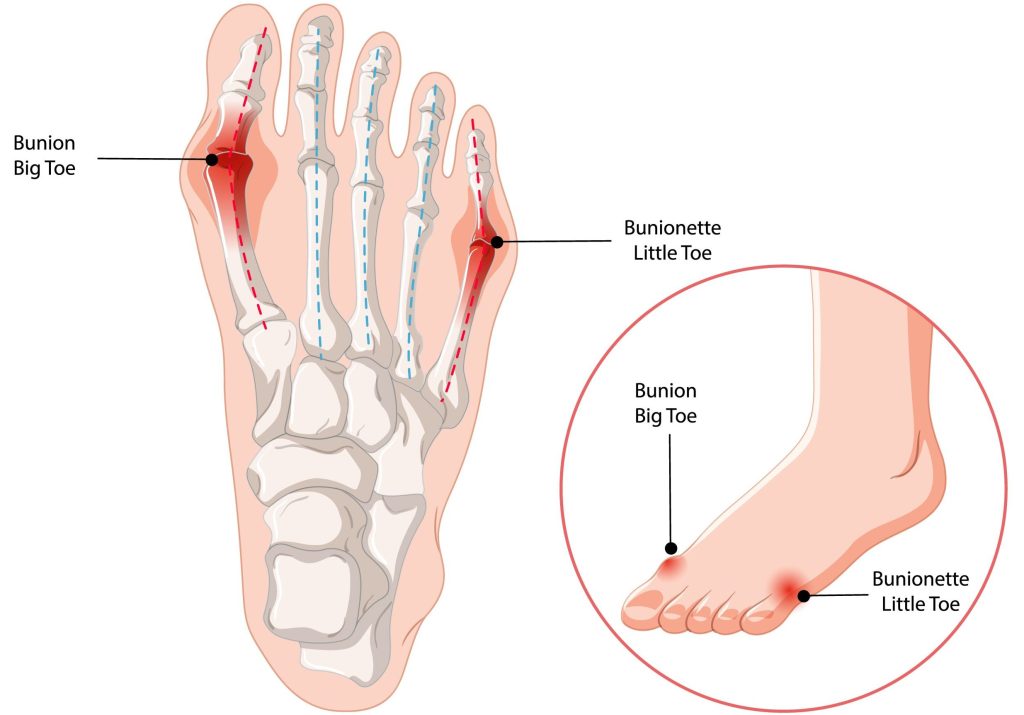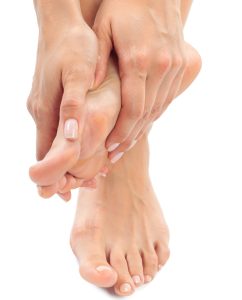Bunion Treatment Palm Beach Gardens, FL
Bunion Treatment at Motion Orthopedic & Podiatry Institute
Motion Orthopedic & Podiatry Institute specializes in comprehensive bunion treatment, offering both non-surgical and surgical solutions to help patients find relief from the discomfort and pain caused by bunions. Bunions, also known as hallux valgus, are one of the most common foot deformities, affecting millions of people worldwide. Our team of experienced podiatrists and orthopedic surgeons provides personalized care tailored to each patient’s specific needs, focusing on alleviating symptoms, preventing further complications, and restoring mobility and comfort.
What is a Bunion?
A bunion is a bony bump that forms at the base of the big toe where the joint connects to the foot. It occurs when the big toe pushes against the neighboring toe, causing the joint of the big toe to move outward and become misaligned. Over time, this misalignment can lead to swelling, pain, and inflammation, especially when walking or wearing shoes.
Bunions are progressive, meaning they tend to worsen over time if left untreated. In severe cases, bunions can affect the alignment of the other toes, leading to additional complications such as hammer toes, calluses, or corns.

Causes of Bunions
Several factors can contribute to the development of bunions, including:
- Genetics: One of the most common causes of bunions is genetics. If bunions run in your family, you may be more likely to develop them. Inherited foot structures, such as flat feet or abnormal bone positioning, can increase the likelihood of bunion formation.
- Footwear: Wearing shoes that are too tight, narrow, or have high heels can exacerbate bunion development. These types of shoes force the toes into unnatural positions, placing extra pressure on the big toe joint.
- Foot Injuries: Trauma or injuries to the foot can lead to bunion formation, especially if the injury affects the alignment of the bones in the foot.
- Arthritis: Conditions such as rheumatoid arthritis or osteoarthritis can cause inflammation in the joints, leading to bunion formation or worsening an existing bunion.
- Flat Feet: People with flat feet are more prone to bunions because flat feet often cause the foot to roll inward (overpronation), which places extra stress on the big toe joint.
- Occupation or Lifestyle: Activities that require standing or walking for long periods, especially on hard surfaces, can increase the risk of developing bunions over time.
Symptoms of Bunions
Bunions can cause a range of symptoms, from mild discomfort to severe pain and mobility issues. Common symptoms include:
- Pain and Tenderness: Pain is typically felt around the base of the big toe, particularly when wearing tight shoes or walking for extended periods.
- Swelling and Redness: The area around the bunion may become swollen, red, and inflamed due to the pressure and friction against footwear.
- Difficulty Walking: As the bunion grows larger, it can cause difficulty walking or standing for long periods, leading to fatigue and discomfort in the foot.
- Changes in Toe Alignment: In severe cases, the big toe may begin to shift toward the other toes, causing them to overlap or become misaligned. This can result in additional issues such as hammer toes or calluses.
- Limited Movement: Bunions can limit the range of motion in the big toe joint, making it difficult to bend or flex the toe.
If you are experiencing any of these symptoms, it’s essential to seek professional evaluation and treatment to prevent the bunion from worsening and causing further complications.
Our Approach to Bunion Treatment
At Motion Orthopedic & Podiatry Institute, we offer a comprehensive approach to bunion treatment, starting with a thorough evaluation of your condition. After assessing the severity of your bunion and discussing your symptoms and lifestyle, we will develop a personalized treatment plan that may include both non-surgical and surgical options.
Non-Surgical Bunion Treatments
For many patients, non-surgical treatments can effectively manage the symptoms of bunions and prevent the condition from worsening. Our conservative treatment options focus on relieving pain, reducing inflammation, and improving foot function.
- Custom Orthotics: Custom-made orthotic inserts are designed to provide support and correct the alignment of your foot, reducing pressure on the bunion and improving overall foot mechanics. These inserts are especially beneficial for patients with flat feet or overpronation, as they help distribute weight more evenly across the foot.
- Padding and Taping: Padding the area around the bunion can help reduce friction and irritation, while taping or splinting the foot can help realign the big toe and prevent further misalignment. These measures can alleviate pain and protect the bunion from rubbing against footwear.
- Footwear Modifications: Wearing comfortable, supportive shoes with a wide toe box can significantly reduce the pressure on the bunion and alleviate pain. We recommend avoiding high heels, narrow shoes, and shoes that crowd the toes. Proper footwear helps prevent the progression of the bunion and provides relief from symptoms.
- Anti-Inflammatory Medications: Over-the-counter nonsteroidal anti-inflammatory drugs (NSAIDs), such as ibuprofen, can help reduce pain and inflammation associated with bunions. These medications are especially helpful for managing flare-ups or discomfort after long periods of standing or walking.
- Ice Therapy: Applying ice to the affected area can help reduce swelling and relieve pain. Ice therapy is particularly effective after activity or when the bunion becomes irritated due to friction or pressure.
- Physical Therapy: Stretching and strengthening exercises can improve flexibility in the foot and strengthen the muscles surrounding the big toe joint. Physical therapy may also include balance exercises to improve stability and reduce pressure on the bunion during movement.
- Cortisone Injections: In cases where inflammation and pain are severe, a cortisone injection may be recommended to reduce swelling and provide temporary relief from symptoms.
While non-surgical treatments may not correct the bunion entirely, they can help manage symptoms and slow the progression of the condition, allowing patients to maintain an active lifestyle without significant pain or discomfort.
Surgical Bunion Treatments
In cases where non-surgical treatments are ineffective, or if the bunion has progressed to the point where it causes significant pain and affects daily activities, bunion surgery (bunionectomy) may be necessary. At Motion Orthopedic & Podiatry Institute, our skilled surgeons are experienced in performing advanced bunion correction procedures that realign the bones and restore normal foot function.
- Bunionectomy: A bunionectomy is the most common surgical procedure used to correct bunions. During this procedure, the surgeon removes the bony bump at the base of the big toe and realigns the bones of the foot to correct the deformity. Depending on the severity of the bunion, different techniques may be used, including osteotomy, exostectomy, and arthrodesis.
- Osteotomy: In an osteotomy, the surgeon cuts and realigns the bones in the toe to correct the deformity. Small screws or plates may be used to hold the bones in place while they heal.
- Exostectomy: This procedure involves removing the bony bump from the joint without realigning the bones. It is typically used for less severe bunions.
- Arthrodesis: In severe cases of arthritis or joint damage, arthrodesis may be recommended. This procedure involves fusing the bones in the affected joint to stabilize the foot and reduce pain.
- Minimally Invasive Surgery: Whenever possible, our surgeons use minimally invasive techniques to correct bunions. These procedures involve smaller incisions and less disruption to the surrounding tissues, resulting in quicker recovery times and less postoperative pain.
Recovery After Bunion Surgery
Recovery from bunion surgery varies depending on the type of procedure performed and the severity of the condition. Most patients can expect to wear a surgical shoe or boot for several weeks to protect the foot and allow it to heal properly. You may need to limit weight-bearing activities and use crutches or a walker during the initial recovery period.
Physical therapy is often recommended after surgery to help restore strength, flexibility, and range of motion to the foot. Our team of physical therapists will work with you to create a rehabilitation plan that supports your recovery and helps you return to normal activities as soon as possible.
While bunion surgery is highly effective in correcting the deformity and relieving pain, it is important to follow your postoperative care instructions closely to ensure the best possible outcome.
The Bunion Treatment Process at Motion Orthopedic & Podiatry Institute
At Motion Orthopedic & Podiatry Institute, we are committed to providing personalized, patient-centered care for individuals with bunions. Here’s what you can expect when you seek bunion treatment with us:
- Initial Consultation: During your initial consultation, our podiatrists will conduct a thorough examination of your feet, review your medical history, and assess the severity of your bunion. We may use X-rays or other imaging studies to evaluate the alignment of your foot and determine the best treatment approach.
- Personalized Treatment Plan: Based on the results of your examination, we will develop a personalized treatment plan that addresses your specific needs and goals. Whether you require conservative care or surgical intervention, we will work with you to find the best solution for your condition.
- Ongoing Monitoring and Follow-Up: Regular follow-up appointments are essential to monitor your progress and ensure that your treatment is effective. Our team will make adjustments to your care plan as needed to help you achieve lasting relief from bunion pain and discomfort.
Why Choose Motion Orthopedic & Podiatry Institute for Bunion Treatment?
At Motion Orthopedic & Podiatry Institute, we understand how debilitating bunion pain can be, and we are dedicated to helping our patients find relief and restore function. Here’s why patients choose us for bunion treatment:
- Expertise in Bunion Surgery and Non-Surgical Care: Our board-certified podiatrists and orthopedic surgeons have extensive experience in treating bunions using both conservative and surgical methods. We are committed to providing the highest level of care to ensure the best possible outcomes for our patients.
- Comprehensive Care: From diagnosis to treatment and rehabilitation, we offer a full range of services to manage bunions and related foot conditions. Our multidisciplinary approach ensures that every aspect of your care is addressed.
- Personalized Treatment Plans: We believe that every patient is unique, and we take a personalized approach to bunion treatment. Whether you need non-surgical management or advanced surgical correction, we tailor our treatment plans to meet your specific needs.
- State-of-the-Art Facility: Our clinic is equipped with the latest diagnostic tools and surgical technologies, allowing us to provide cutting-edge care in a comfortable and supportive environment.
If you’re suffering from bunion pain or discomfort, Motion Orthopedic & Podiatry Institute is here to help. Contact us today to schedule a consultation and learn more about our comprehensive bunion treatment options. Let us help you get back on your feet with expert care and personalized attention.
- Orthopedic Surgery
- Podiatry Care
- Regenerative Medicine
- Sports Medicine
- Vein Treatment
- Arthroscopic & Joint Replacement Surgery:
- Knee Pain
- Shoulder Pain
- Hip Pain
- Sports Injuries
- Tendonitis and Bursitis
- Carpal Tunnel Syndrome
- Trigger Finger
- Wound Care
- Concierge Orthopaedic Services